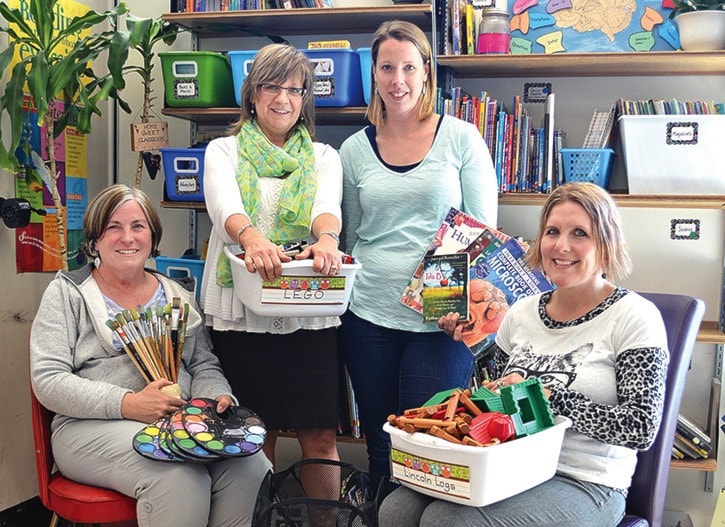Walk into any elementary school classroom and there will no doubt be colourful borders on bulletin boards, alphabets tacked to the walls, crafts in the corners and science experiments in progress.
What might not be readily apparent is that the majority of those colourful and engaging learning tools were likely purchased with the teacher’s own money.
In this week’s instalment of the Black Press/Staples Great Teachers feature series, we speak on that subject with four educators from Sidney elementary.
 “If a school suddenly went from having 12 divisions one year to having 13 divisions the next year, that teacher would walk into a bare classroom,” says Grade 4/5 teacher Jennifer Alberring.
“If a school suddenly went from having 12 divisions one year to having 13 divisions the next year, that teacher would walk into a bare classroom,” says Grade 4/5 teacher Jennifer Alberring.
“You’d have the furniture, and whatever you could scrounge from everyone else,” adds Grade 2/3 teacher Lisa Kjernisted.
Her classroom is full of cool stuff: buckets of paintbrushes, positivity posters, and a whimsical, oversized leaf at a cozy reading station. It’s the kind of classroom any kid would love to hang out in, and it’s where Kjernisted, Alberring and fellow Grade 2/3 teachers Lori Richards and Nancy Fredeen have gathered to talk about how much they actually spend on classroom supplies every year.
The four have more than 80 years combined teaching experience, and they’re pretty much in agreement on the minimum amount of personal money they spend each year.
“At least $200 to $300 over what (the parent advisory council) gives us, easy,” Fredeen says. And that’s for a teacher who’s settled in one school, teaching a regular grade. Having taught as an on-call teacher for a number of years, she says expenditures can skyrocket for substitutes, up to and often over $1,000 each year.
“I bought a lot as a substitute teacher, and a lot of books. I had a kindergarten box and I had a Grade 5 box,” she says. “Some schools have a lot, some schools don’t have very much at all.”
Add in crafts for Mother’s Day and Father’s Day, Christmas projects, small birthday tokens for their students, art supplies, and it all adds up. “You have to get really creative,” says Richards. “It’s easy to spend $100 a month.”
“I’m constantly thinking, how can I make this cheaper, but still nice so the kids can be proud of it,” says Kjernisted.
She and the others are quick to stress how hard their PAC works to raise money for supplies.
In addition to raising money for field trips and school programs, the PAC provides teachers with $200 to $300 each year from fundraising efforts like bake sales, craft fairs, silent auctions and the like, but it’s rarely enough.
“People say jokingly in October, ‘I’ve already spent my budget for the year,’” Alberring says.
Even something as simple as a basic science experiment: mixing flour and water to create a non-Newtonian liquid, can be an issue. The teacher needs to find flour and sometimes it’s easier to pick it up with the family groceries, says Alberring.
Her class bookshelf is full of adventure novels, science books and everything in between – mostly bought with her own money. “We value education, which is why we’re putting our money into it, she says. “And the parents value it, which is why they work so hard fundraising.
“We don’t begrudge it. We want to be in a classroom environment that’s beautiful and that the kids get value out of. We always have and we always will.”
Nominate your Great Teachers
You can nominate the awesome educators in your life by clicking on this link: GREAT TEACHERS and following the directions to register, then fill in your nomination form. The deadline is May 31.
Related stories:
GREAT TEACHERS: Going green in a multitude of ways at Reynolds
GREAT TEACHERS: Technology playing a key role in today’s classrooms
Black Press and Staples ask you to think about Great Teachers in your life
